The Train Stops At Nandigram
By Amit Sengupta
After 30 years of being big bully, big brother in Orwellian West Bengal, with ‘Buddha’ being equated with Narendra Modi as ‘the role model of development’ , Nandigram might mark the epitaph of the CPI(M) in ‘India Shining’.
Those days, in the early 1970s, the slogan used to be in a fiery rhythm, almost a melody: Aamar Naam, Tomar Naam, Shobaar Naam: Vietnam… Vietnam…Aamar Bari, Tomar Bari, Shobaar Bari: Naxalbari… Naxalbari… Literally, it means, my name, your name, everyone’s name: Vietnam, Vietnam; my home, your home, everyone’s home: Naxalbari, Naxalbari. So it is not unpredictable or jarring, when the slogan, in 10 per cent growth rate,
‘Manmohanics India of March’, 2007, turns out to be as rhythmic and beautiful, almost Gandhian in its rooted simplicity: Aamar Gram, Tomar Gram, Shobar Gram: Nandigram, Nandigram.
My village, your village, everyone’s village: Nandigram, Nandigram.
Like a flash of memory, and an inverted image of camera obscura, the slogan resurrects vicious cycle of epic tragedies: thousands of farmers in village after village committing suicides, every day, non-stop, in Vidharbha, Sangrur, Ananthapur; and thousands of farmers, dalits, tribals, being forcibly displaced to benefit big business and big projects, in Kashipur, Kalinganagar, Bastar, Punjab, Dadri, the Narmada valley, Tehri Garhwal.
Those days, in the early 1970s, the eclectic post-freedom idealism had failed. The dream of a young democracy after protracted sacrifices by revolutionaries like Bhagat Singh, Sukhdev, Rajguru, Batukeshwar Dutt, Khudiram Bose, Jatin Sen, Chandrashekhar Azad, Ashfaqullah Khan, Ramprasad Bismil, among thousands of others, had been subverted and sucked into a black hole of greed, injustice and inequality by the new feudal and economic elite. Those days the story was that the train never stopped at Naxalbari. And why should the train stop in that obscure village silence in West Bengal, near Siliguri and Darjeeling?………
No one would then know that this silence would one day become a spring thunder, heard across the world, become etched as a landmark of history, a rupture within and outside the ‘official Left’. Four decades after this sudden, stunning, spontaneous uprising rocked West Bengal and other flash-points in ‘unfree India’, followed by cold-blooded State repression whereby an entire generation was wiped out by the Congress and CPI(M) establishments, will Nandigram become another Naxalbari?
“Yes,” says Dipankar Bhattacharya, General Secretary, CPI-ML (Liberation) . “Nandigram will mark a turning point in history. It will reassert the struggle of village India, the poorest farmers, versus the corporate sharks who are backed by the State. In West Bengal, the CPI(M) has become an agent of the
capitalists. Look at the irony, between ‘Siddharth’ Shankar Ray, who led the elimination brigades after Naxalbari along with the CPI(M), and Buddhadeb
Bhattacharjee, the current icon of capitalism, the similarity is not only of politics, but also of name: both mean ‘Buddha’ but both are a shame on Buddha. If the CPI(M) continues this repressive and brazenly pro-business, anti-farmer politics, it will create space for the Right-wing in Bengal. And we will not allow that to happen.”
So it is significant that March 23 marked the 100th birth anniversary of Bhagat Singh. This year also marks the 150th anniversary of the great anti-British rebellion of 1857, which Marx called the first war of Indian Independence. And since history takes you by surprise, you become blind when it stares you at point-blank range. Because here, in the heart of Delhi, in memory of the martyrs of 1857 and Bhagat Singh, and in protest against the Nandigram massacre and SEZs, almost 2,50,000 people, the poorest of the poor from all parts of rural India, waving tens of thousands of red flags, shouted in one voice: SEZs murdabad, Nandigram lal salaam, Inquilab zindabad.
They came in disciplined, non-violent, totally committed and organised groups led by the CPI-ML (Liberation) : from Giridih in Jharkhand and Arwal in
Jehanabad, to Singur in Bengal, Sonebhadra in UP, Karbi Anglong in Assam, Mansa in Punjab and interiors of South India. They came in waves of red, the people of India, the invisible majority; there were no traffic jams, no violence, not a moment of metropolitan disruption. This was perhaps the biggest
rally in years in the capital and the topical backdrop was the Nandigram massacre.
Next day, not a word was reported in any of the big papers in Delhi. Not one word. As if, this India, this massive protest, does not exist.
But this India exists, in affirmation and hope, in sacrifice and struggle, in dissent and resistance. Because revolutions don’t happen in Lakme fashion shows or in the big bucks of schizophrenic cricket, when the entire media lost it. People learn from history, from mistakes of the past. Revolutions move relentlessly in invisible spirals, of quiet, volcanic, unseen social unrest, in the daily struggles of survival and despair, when the radical turning point is waiting in the next bylane of an unknown village. Like Naxalbari, Nandigram and Kalinganagar. And when it happens, even the ‘official Left’, riding the bourgeois bandwagon, goes berserk, as the CPI(M) cadre and police did in the massacre of Nandigram. To protect the interests of a notorious MNC Salem, which aligned with dictator Suharto, when 2 million communists, dissenters and human rights activists were killed in Indonesia. No wonder Buddha says that capital has no ideology or colour.
Almost the entire country is witness to this revulsion, this brazen sell out of the Left to the Right. “If you want to behave like a capitalist party, declare it openly and go ahead. But don’t kill people,” said Prabhu Mahapatra, professor of history at Delhi University, in the protest in Delhi one day after the massacre. “The genocide is not over. The genocide is going on. Now. And why have the Left allies lost their speech?” asked an anguished Sumit
Chakravarty, editor, Mainstream, joining the protestors. “The CPI(M) cadre and the police have become agents of the corporates. They have unleashed a reign of terror. They want to teach a lesson to all those who are protesting against forcible land acquisition, ” said Medha Patkar, who has repeatedly
fought her way through police barricades into the prohibited zones of Nandigram and Singur. Even as I write this, she is in jail, as the ‘Sangharsh 2007′
campaign of hundreds of people’s movements, take on the UPA government, backed by the Left Front. While seeking a ban on privatisation of water outside Montek Singh’s Planning Commission, she and other activists were smashed by the police, and packed off to jail.
Across the spectrum eminent intellectuals have protested against the CPI(M) policies in Bengal: historians Romilla Thapar, Tanika Sarkar, Sumit Sarkar, novelist Arundhati Roy, journalist Praful Bidwai – and they are not right-wingers, so even the CPI(M)’s propaganda machinery can’t brand them and get away. What is also significant is the eerie silence of the ‘CPI(M)’ intellectuals, including economists Jayati Ghosh, Prabhat Patnaik, Utsa Patnaik, CP Chandrashekhar and CPI(M)’s cultural front, Sahmat, even while an unrepentant Sitaram Yechuri and Brinda Karat blamed the people of
Nandigram for the massacre. It took two weeks for these intellectuals to issue a muted statement.
Not surprising, because the CPI(M) also supported the Tiananmen Square massacre, and branded the fasting pro-democracy students as ‘CIA agents and juvenile delinquents’ . And doesn’t Nandigram remind of the Gujarat genocide: murderous, rapist VHP/Bajrang Dal mobs unleashed, backed by the police and the BJP regime?
A poster said it all in Delhi: Capitalist Party of India (Murderers) – CPI(M). After 30 years of being big bully, big brother in Orwellian West Bengal, with
‘Buddha’ being equated with Narendra Modi as ‘the role model of development’ by Right-wing journos, this poster might mark the epitaph of the CPI(M) in this neo-liberal epoch of ‘India Shining’. Because these days the train stops at Naxalbari. As it will, in Nandigram.
Because, your village, my village, everyone’s village is Nandigram, Nandigram
Source: Countercurrents.org



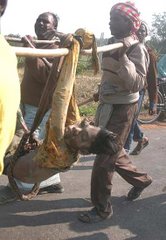
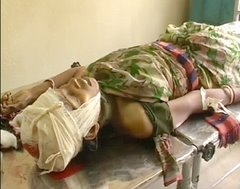

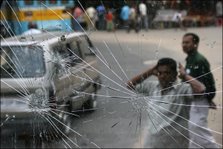
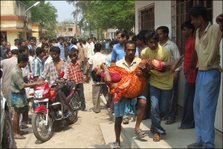

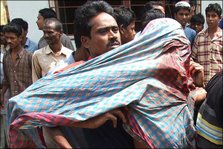


No comments:
Post a Comment